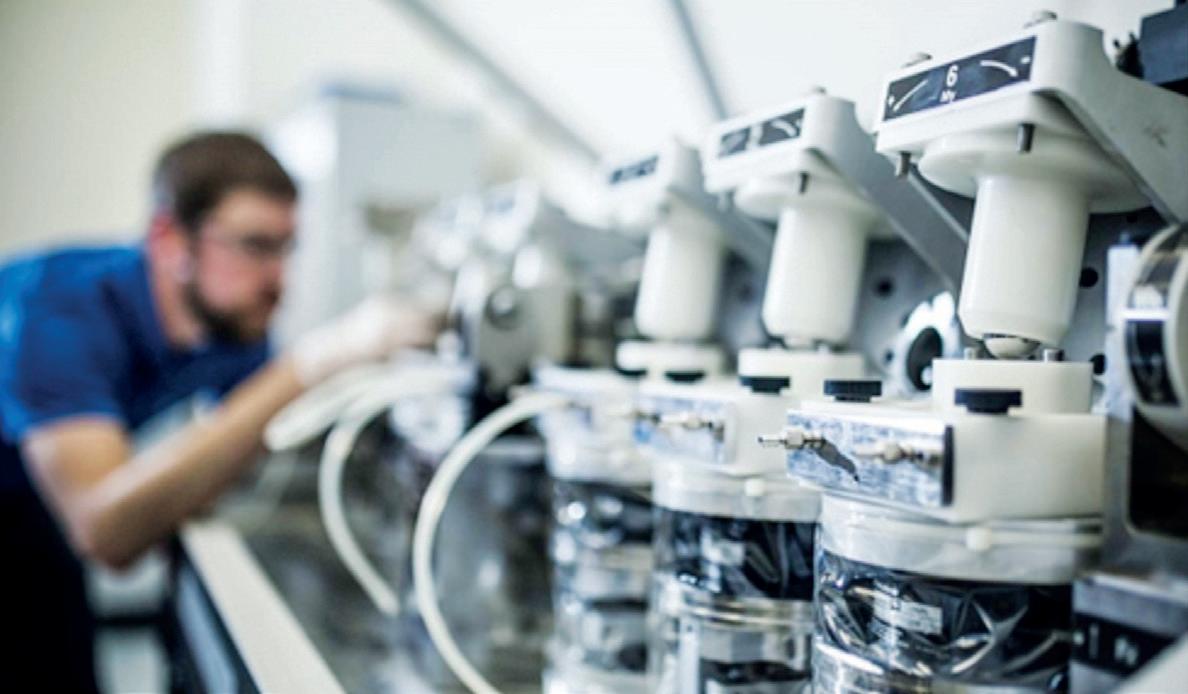
12 minute read
Testing and inspection
from MPN NA Issue 21
by MPN Magazine
MIKE JOHN, TECHNICAL DIRECTOR FOR IRELAND AT THE SEMPRE GROUP, EXPLAINS HOW METROLOGY CAN BRING THE MEDICAL DEVICE DESIGN AND MANUFACTURING PROCESS TOGETHER.
While ISO 13485 sets the standard for quality management systems (QMS) in medical device manufacturing, metrology is often treated as an afterthought and simply used to validate products and detect defects at the end of production. The result? It becomes harder to prove consistent quality and the validation process can become fragmented.
DRAWING AND REPORTING Every medical device starts with a concept and a drawing, and a manufacturer must find the best way to convert this 2D drawing into a 3D, functioning product. Traditionally, this requires engineers to manually outline all the individual dimensions and requirements of the part, creating a ballooned image that they can use to manufacture a final product. A First Article Inspection (FAI) report is a design verification and historic file that provides reported measurements of the first manufactured parts to ensure that it correlates with the drawing, showing that the device functions as intended and meets the application’s requirements. However, collecting data manually often means this step of the process is time consuming and can introduce human error, which is not an option in this highly regulated industry.
One solution is to automate the ballooning and FAI reporting process where manufacturers can benefit from having a centralized data collection point that enables them to automatically compare ballooned drawings to pass FAI reports. For example, the High QA Inspection manager allows engineers to scan entire drawings, or multiple pages, in one click. It automatically extracts the geometric dimensioning and tolerancing (GD&T) data and critical dimensions, with all the tolerances automatically allocated. QUALITY PRODUCTION CAD models are now being created instead of 2D paper drawings and the information contained in these files can also be ballooned using the same software. This data can also be linked into computer numerical control (CNC) machines or another production system to produce the component. As well as proving quality assurance, manufacturers should use data to learn more about their prediction process so that they can review part quality and resolve issues head-on.
As well as reporting, manufacturers can use data and software to make proactive changes on the shop floor during production. For example, a Reaction Plan manager is an automated instruction-based software that analyses measurement data, calculates offset and provides tool correction instruction. If a part fails to meet specification, the software will instruct the operator how to adjust the machine to correct the problem.
When measuring small, intricate components, Original Equipment Manufacturers (OEMs) get the most accurate results quickly when the part under inspection is secured. Fixtures are key when inspecting medical components, such as syringes, because they provide 360-degree access and keep them in place without exerting too much pressure and damaging the part. Therefore, they facilitate ISO 13485 compliance because every part is measured in the same orientation, minimizing inconsistency.
REPRODUCIBILITY Accuracy is critical to medical device compliance, so knowing that all measurements are repeatable and reproducible is essential. After parts are produced, manufacturers can assess gage repeatability and reproducibility data (GR&R) to certify that the measurement output is the same value as the input, and that the same measurements are obtained under the same operating conditions over a set period.
Integrating highly accurate CMM and metrology systems is a good starting point for ensuring repeatability. For instance, the Micro-Vu Vertex has a 2-micron accuracy and a 0.1-micron resolution, and it facilitates automated reporting, including GR&R documentation.
Metrology specialists like The Sempre Group can provide an endto-end turnkey solution, assessing quality testing needs and making recommendations throughout the manufacturing process. A good partner will not only supply the measurement system, but assist with the programming, validation and reporting that comes with it.
THOMAS MILNES, INDUSTRIAL DESIGN CONSULTANCY LIMITED, HIGHLIGHTS SEVERAL MISCONCEPTIONS RELATED TO INSPECTION PROCESSES DURING MEDICAL DEVICE DEVELOPMENT.
MISCONCEPTIONS BETWEEN DESIGN AND MASS PRODUCTION
To keep up with the demand of high standards and fast time to market in medical device development, it is necessary to ensure development methods are optimized. Harnessing inspection processes during the development phase can ensure a smooth transition between design and production.
1. THE MORE INSPECTION, THE BETTER THE COMPONENTS WILL BE It may seem logical to designers that including a more detailed component specification will lead to more thoroughly checked but taking this approach can lead to unwanted drawbacks: - Increased inspection time – The more dimensions/inspection points specified on the technical drawings, the longer the parts will take to inspect.
Given some components can go through many samples before finalization, removing unwanted inspections should reduce development time. - Specification changes – Due to the complexity of production manufacturing processes and plastic materials, it may be that initial component samples are not completely accurate in all areas. - Prioritization of the specification – If the specification is over-extensive for each component, the manufacturers may not know which areas to prioritize.
2. WIDENING TOLERANCES AND COMPONENT SPECIFICATIONS WILL REDUCE PROJECT COSTS Designers will sometimes focus on loosening tolerances and reducing testing to try and speed up development and save money. Certain things should be considered before widening part specifications: - Design constraints - Considering the design inputs will set constraints for the design such as size and weight, when all these constraints are laid out, defining the individual component specifications should be easier. If defined correctly, there will be less chance that these specifications will need revisiting later. - Tolerance stack-up - If tolerances are loosened without consideration of the device’s intended function, the risk of device failures may increase.
Tolerance stack-up calculations should help determine which can be loosened. - Manufacturing capabilities – Liaising with the manufacturer could determine where the tolerances can influence cost. - Material capabilities – For molding processes, the material itself can limit tolerance capabilities. Raw material suppliers are generally aware of the limitations of their materials, and they may have alternates available.
Ultimately, defining the component parameters well initially, should mean less component and specification modifications, this can directly improve overall product quality, reduce project cost and ensure the project is delivered on time.
3. INSPECTION IS SUFFICIENT ON ITS OWN, THERE IS NO NEED TO TEST There is a wealth of potential testing methods for many scenarios, and it should be evaluated whether there is a reason to test a device or individual components during early development. If inspection is the sole method of sample analysis during development, certain elements could be missed: - Unseen imperfections – Components may have imperceptible imperfections which influence their properties, such as contamination, preconditioning influences, moisture absorption etc. - Complex interactions –
Inspection can be a vital tool in reviewing components, and engineering calculation combined with material research can help designers understand the interactions between parts.
However, testing real part interactions could highlight any potential issues with interactions. - Complex properties – Plastics and their properties do not always easily translate to theory, these issues should be picked up by aging studies but may not be picked up by theoretical approaches.
Inexperienced medical device designers can rely too much on theory; inspection can provide information where testing does not, and vice versa, so using both inspection and testing methods helps give the device the best chance of moving quickly through the development phase.
Inspection can be a useful tool to ensure successful development of medical devices when used correctly. Ensuring component specifications are defined realistically and with justification, and at the same time understanding the limitations to inspection, should translate into more successful projects.
KISTLER GROUP CREATES EQUIPMENT FOR INSPECTION OF PARTS THAT CAN BE USED IN THE MAKEUP OF MEDICAL DEVICES. MEDICAL PLASTICS NEWS SPOKE WITH THEM AT MD&M WEST TO SEE WHAT DEVICES THEY HAD ON SHOW.
Passing the test
Kistler is well-known for its range of process monitoring and measurement solutions for medical device manufacturing. The devices that were showcased at MD&M West were no exception.
When looking at the machines, Curtis Krick, plastics & advanced manufacturing manager at Kistler Group, said: “What you want to do is see and understand how the faults occurred. So, if you have a root cause you can then identify and say, ‘I can re-simulate these’. Once you reset and evaluate the faults, then you’re able to put the criteria in to keep it from happening again. And you’re able to control the process.
“You want to know the specific conditions that caused this problem. We have systems that would be considered AI because they do have intelligent learning capabilities and these models say, ‘this is what we predict the problem will be just based upon estimations of what the specific conditions might be’.”
Process monitoring systems play such an important role when creating medtech devices; they can prevent something going wrong, ensure there are no faults, make the manufacturing more efficient and avoid recalls. Kistler’s machines help manufacturers meet the requirements of the healthcare market, making production a lot more efficient.
The company showcased ComoNeo, which supports injection molding. Kistler claims the system is more accurate than before and supports users throughout the entire validation process, due to its newly added features. The user management and trail functionality help maximize safety and security whilst its extended user interface boasts a reliable transmission of data to the injection molding machine.
The test automation for continuous materials is critical for manufacturers and this is where the company feels KVC 621 has its benefits. This universal video measurement system focuses on high, individually adjustable speeds. Kistler insists this machine achieves reliability and operates with a processing speed of up to 6000 measurements per minute.
“You can know exactly where something was wrong or off, you can then have all that information. We can backtrack to what was wrong with those parts. So, you can go back and look at all of that and see this part was fine and this one was bad.” Kyle Fischer, IPC field sales engineer at Kistler Group, explained. “And then you have the exact data, so you can see exactly where you heard it was bad, or if it took more force or anything to assemble a little, you can go back and say ‘all right, you guys did this wrong, fix this’.”
Kistler’s aim is to ensure that the whole production cycle is covered. They were showcasing machines that can test every element from design to manufacturing the finished product, making the manufacturer’s job much simpler.
Stephan Vogel, head of international business development at Kistler Group, said: “You industrialize it through the process, validation, qualification, everything, and then you start production. If we need to have vision inspection or if they want more properties or different properties, we offer all of that too.
“So, we have all the interfaces that are necessary today with all the industrial feed passes; you get it all out on one hand with one consistent data quality and data handling which is the biggest advantage that our customers have. In process monitoring, it’s not only the product testing, process monitoring, but the whole value chain of the selection.”
FOOD PACKAGING COMPANY, PFF, HAVE SHARED THEIR JOURNEY ON CREATING PFF HEALTH TO HELP COMBAT THE CORONAVIRUS.
PACKING UP THE PANDEMIC
PFF Health is part of PFF Packaging Group, a privately owned food packaging manufacturer in the UK. During the Coronavirus pandemic, PFF used its expertise in the food sector to meet the increased global demand for Personal Protective Equipment (PPE). In early 2020, PFF won a Department of Health and Social Care (DHSC) contract to manufacture polythene aprons for frontline NHS staff and social care workers. PFF created over 100 jobs for the duration of the contract and invested more than £2m in custombuilt machines to manufacture the aprons, ramping up production to 24 hours a day, seven days a week.
Polythene aprons, along with other PPE items, became, and remain, a vital source of protection for health workers. Once they were up and running, PFF began to look for greater efficiencies and scoped out a blueprint for bespoke apron manufacturing machinery. Collaborating with British machine manufacturer Hanbury-Autogil, PFF commissioned two specialist machines - the fastest in the world, designed and manufactured in the UK. These machines now form the backbone of their manufacturing capacity. To date, PFF has supported the UK Government and DHSC, having manufactured just under 400 million aprons.
Traditionally polythene aprons contain little recycled material and PFF Health is seeking to change this. PFF is using our expertise and that of their partners in a major project to significantly increase the recycled content of the aprons we supply.
PFF Health is working with several medical device businesses to design both standard and bespoke solutions for medical product components and packaging solutions. Using their expertise gained over many years in the food industry, they will re-design products to reduce the weight, and therefore the quantity of plastic required. Crucially, they must ensure that product performance is not compromised, and this is where they work in partnership with their clients. PFF has established a Regulatory Project Group and will work with businesses to ensure the correct quality standards are met.

Where an end product requires sterilization, samples can be test-sterilized and examined. The polymers used will be influenced by the sterilization method. PET/rPET is not ideal if the product is to be sterilized in a high temperature autoclave. A better polymer in this instance might be PP. Polypropylene itself is a good all-round raw material and it is no surprise that many medical components and packaging are manufactured using it. The company claims that their designs and achievable weight savings can range from 10% to more than 40% and this can become a significant contributor to the overall objective of the NHS to become net zero.
The NHS has two targets for its carbon footprint. Firstly, for emissions that it can directly control, it will reach net zero by 2040 and will achieve an 80% reduction by 2028-32. A broader target ‘NHS Carbon Footprint Plus’ focuses on the wider carbon footprint of the NHS and will directly impact medical device manufacturers, both the devices they produce and the carbon impact of freight transport. This target states that the NHS will reach net zero by 2045 with an ambition to reach an 80% reduction by 2036-39.
This means that going forward, the UK can no longer simply source products from around the globe while ignoring the carbon impact of doing so. The impact of the pandemic, as well as previously unthinkable events such as the blockage of the Suez Canal, have starkly exposed the UK’s supply chain vulnerabilities.






